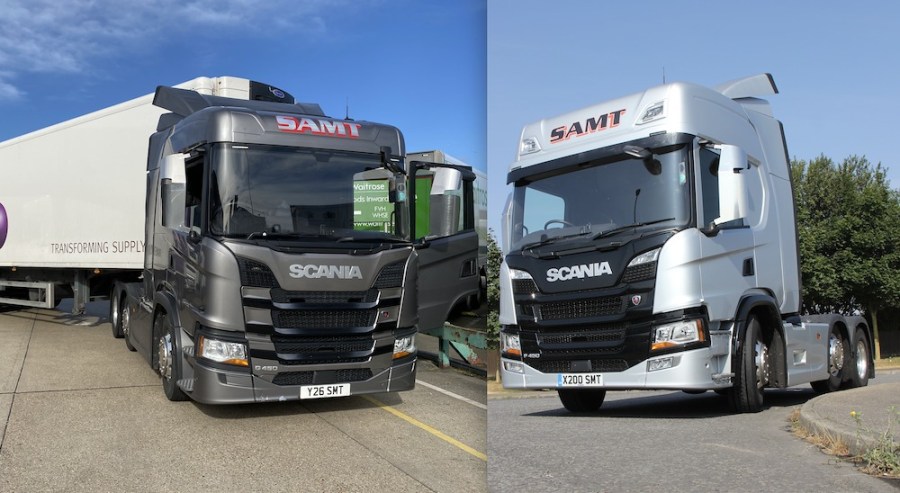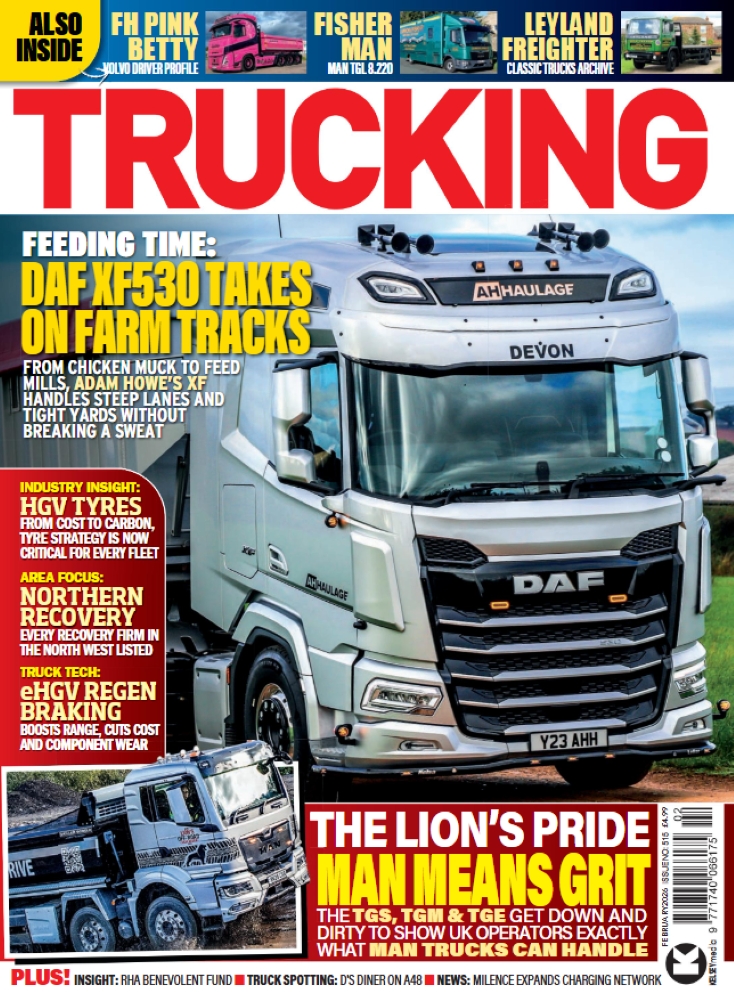We take two nearly new Scania P and G models with the same driveline, but different cabs, out on extended ‘test drives’ in the real world
The Coronavirus pandemic that has riddled the country has, understandably, meant the trade press can’t get hold of vehicles for road tests or driver appraisals. But panic-buying has put extra strain on the UK’s logistics industry and so anyone with an HGV licence can, most probably, get some driving shifts if they wish.
So when we volunteered our services to a local haulier for a bit of additional weekend work should they need it, they practically bit our hand off. It also gave us a chance to have an extended drive of two Scania 450s – not an S or an R, but a P450 6×2 tractor and a similar G450.
So this Driven piece is not appraising brand new manufacturer’s vehicles, but ‘proper’ working trucks. As it’s not been easy to get Scanias for road test recently, at the time of going to press (and as far as we are aware) there has been no long road test of either of these models in this form.
But we’re actually thankful for that. We have long argued press demo trucks need to be more like the kind of trucks the majority of drivers will get their hands on. The problem is, press demo vehicles are brand new and usually have all the option boxes ticked – leather seats, in-cab infotainment systems and so on – and often with the biggest engines, and not always a true representation on what will actually go on the road in the big fleets.
So for this road test, we are driving trucks a little over two years’ old and with over 300,000 km already on the clock. That said, both were immaculate and you could divide their mileages by 10 and it wouldn’t have raised an eyebrow.
We’d also add that the two trucks have not changed since production started. A G450 you put on the road in 2018 would be the same as one you put on the road in 2020 – and the same for the P450.
Technical overview
Scania has five different cabs on offer (L, P, G, R and S) and its modular construction techniques means there’s a huge amount of overlap of these cabs and engine options. Take the quirky, specialist L-series out of the equation and it leaves the offering of four decent cabs for distribution and long-distance haulage. The majority of engines used by UK hauliers for general 44-tonne work are the 13-litre straight-six and the 16-litre V8. Most of the sensible hauliers go for the former.
The 13-litre has 370, 410, 450, 500 and now 540 bhp outputs. All are available with P, G, R and S cabs with the exception of the 540, which is not available with a P cab. For most UK operators, the 450 and 500 are the best bet – though if you need a little bit more grunt, the 540 is perfect fit.
Scania offers 6x2s as mid-lift or tags, and again the former are by far the most common. Working on the ‘industry standard’ of 10 bhp per tonne, then the 450 is bob on. Both these trucks share the same driveline, and the only difference is in the cab. And even here, there’s not a great deal between them. In fact, only the best truck-spotters would be able to tell them apart unless they were side by side. But the G is a couple of inches taller. The difference between the P and G in New Gen is minimal, whereas on the old cab, it was the difference between the G and R that was harder to spot.
The key difference you notice is the P cab has two steps, while the G has three. On these two trucks, the P had the high-roof sleeper, and the G had the normal roof (which is taller than the flat roof).
The driveline is the DC13 which delivers 450 bhp at 1900 rpm and 2350 Nm of torque at 1000-1300 rpm. It uses SCR technology to meet Euro 6 emission standards. The gearbox is the 12-speed Opticruise.
On the road: G450
The other good thing with doing a road test on a proper working vehicle means we can get a much better feel for the truck and use the features we don’t often get to stress on a press test. We never get to uncouple trailers on test, fuel the truck, reverse into tight spaces and so on.
We took the G450 from Spalding, collected a loaded fridge trailer and headed for Aylesford in Kent. Once tipped, it was a case of running back empty to Ramsey to reload, and then back to the RDC to drop the trailer before returning to the truck’s yard.
All told, it was a good 500 km of trucking – and it didn’t take too long to realise this was a nice truck to drive. It handled impeccably and the cruise control was excellent. The two-stage engine brake was also easy to use and effective. With good anticipation of the road ahead, these two features seriously limited the need to rely on the footbrake and accelerator.
One thing that’s noticeable is it’s a lot noisier in the G cab than in an R or S cab. That’s easily explained: the cab sits lower so there’s an engine hump, meaning the driver is closer to the throb of the engine. We quite like the sound of an engine hard at work, but it’s not intrusive and it does not lead to an uncomfortable drive.
The dash on the New Gen Scanias is superb and it’s good that many buttons have been moved to the window. We can’t help wondering if Scania will follow the trend of ‘tablet’-style touchscreens sometime soon.
One issue with the smaller Scania cab is the windows do not fully lower, and this a minor irritation – especially when you consider these trucks will be used on lots of multi-drop work where the driver will be undertaking several reversing manoeuvres onto bays and the like. There was also a noticeable rattle on this truck’s driver’s side window; but again, not too intrusive.
Drivers first
Scania has long put the driver at the forefront of everything it does in cab design and there are lots of small things to be appreciated. One really good feature is the ability to have the radio on, your phone charging and be able to use the electric windows even when the keys are out of the ignition. This is brilliant given so many RDCs make you hand in your keys when you are on loading bays – and as we all know, loading and unloading is not always instantaneous!
And talking of reversing onto bays, there is a handy function to enable a ‘crawl’ mode when reversing to make it easier and less likely to end in a bump.
The G450 we had was a single-bunk sleeper, and that’s fine for the odd night. Access to bunk for a power nap while waiting is easy enough. Moving around the cab is fine, but for anyone doing more than two or three nights out, then the higher-roof option would be preferential. For week-out trunking, it’s clear the R and S cab are better bets. But overall this is a superb cab and it’s easy to see why more Gs are appearing.
On the road: P450
Like the G450, its (slightly) smaller stablemate was an easy, enjoyable and comfortable drive. It pulled exceptionally well, even with a hefty load in tow. It handled wonderfully, with precise and positive steering.
The P450 had the higher roof and had ample storage, with three decent sized lockers both above the single bunk and above the dash. For a small cab, there’s plenty of room and, again, you can easily do multiple nights it in comfortably if you should need to.
Being the smaller cab, the P450 had two step access and after getting in many times in the day, we began to appreciate it (especially compared with the S650XT we were in a few days previously!).
We had the P450 for a 400 km run from Spalding to Chelmsford (loaded), then empty to Ely to reload and back to base. The final leg of our day was fully loaded and in the dark, and it was incredibly pleasurable. The full-beam lights were fantastic when we could use them.
At the end of a long and intense day, the comfort of the truck makes life so much more enjoyable. It handled so well, we finished our day relaxed and stress free. It pulls away so well and we find it’s almost impossible to fault the driving experience.
Verdict
First up, the trucks themselves. Both are excellent, well-built and a joy to drive. The access is good, especially on the P-series. Even though they both have an engine hump, the ability to move around the cab is welcome for trucks in this class.
What these trucks demonstrate is they are the right spec for the job they do. For occasional nights out, but running at full weight, a P or a G is perfect. The ability to have a comfortable night out or even a comfortable rest is there. The only downside is those windows not going down fully, which is an irritant. Not a huge deal, but annoying all the same.
Being lower down affords a better view of potential hazards and reduces blindspots. That is a good feature.
Economical and operational sense dictates more Ps and Gs should be on the road, so why aren’t they? Well, sadly many trucks you see on this kind of distribution work are on contract hire, so they are easier to sell if they have a big cab. Then there is the driver shortage – and here again, big cabs ‘sell’ the job better. We know of many drivers who want a flat-floored ‘big’ cab, even though they don’t do many (or any) nights out.
We’ve argued for many years now that many trucks sold are sold with their second user in mind, rather than being the perfect fit for the first user. Small trucks like this – and the DAF CF and Volvo FM – offer many advantages: they are cheaper to buy, weigh less and have better access. Yet all too often, operators still plump for a bigger cab. In many respects it makes little or no sense at all.
But in this weight category and specification, the P and G are certainly the best in class. They deliver outstanding fuel returns, ooze quality and drive like a car. But that does not mean Scania will kill off the opposition. Price remains a key issue, as does dealer back-up. You won’t get a P450 for anywhere close to the same price as a DAF CF450, for example.
For total cost of ownership (TCO), the price differential stars to reduce. Also, Volvo’s new GM, Merc’s revamped Actros and even MAN’s new-look TGL are all real contenders in this class, so Scania certainly hasn’t got the market wrapped up.
If you want a truck with a decent engine, a superb cab and one your drivers should love, but don’t want a big cab, then these two Scanias are well worth a look. Comparing these two models, we preferred the P450 just a little bit more. We might have changed that judgement if the G450 had the Highline roof, but we just really enjoyed driving the P450 and would happily take this for a longer run without any qualms whatsoever.
We like
- Build quality
- Dash layout
- Engine brake
- Cruise control
- Cab access
We didn’t like
- Side windows not fully lowering
- Noisier than S cab






